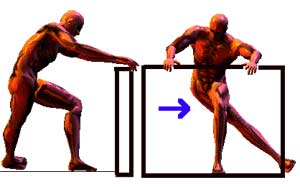Thanks to friction, we can sit, walk, and work easily; it keeps our books and pens still on the table, prevents the table from sliding on the floor, even when it’s not pushed against the wall, and ensures that pens don’t slip out of our fingers…
Friction is such a common phenomenon that we rarely notice its beneficial effects, often taking it for granted as a natural occurrence.
 |
| Without friction, everything would slide away and roll endlessly until they reach a stable position with respect to each other (Illustration: rice.edu) |
Friction provides stability to objects. A carpenter smooths the floor so that when furniture is placed, it remains stationary. Cups, plates, and spoons on the dining table stay still without needing our special attention, unless there’s an unusual rocking situation like on a ship.
Imagine if we could completely eliminate friction; no object, whether as large as a boulder or as small as a grain of sand, could rest stably against another. Everything would slide and roll until they found a truly balanced position relative to one another. Without friction, our Earth would be a smooth sphere like a water droplet.
It’s worth noting that without friction, screws would fall out of walls, no object could be held firmly in hand, whirlwinds would never cease, and sounds would not fade but would echo endlessly, reflecting without any weakening against the walls. Every time we walk on ice, we receive a clear lesson reinforcing our belief in the special importance of friction. Walking on icy streets or muddy roads after rain makes us feel helpless and always on the verge of falling…
However, in engineering, people can take advantage of very low friction to serve useful purposes. For instance, sleds glide over ice, or ice roads are used to transport timber from harvesting sites to railways or to rivers for rafting. On these smooth ice “rails,” two horses can pull up to 70 tons of wood.


















































